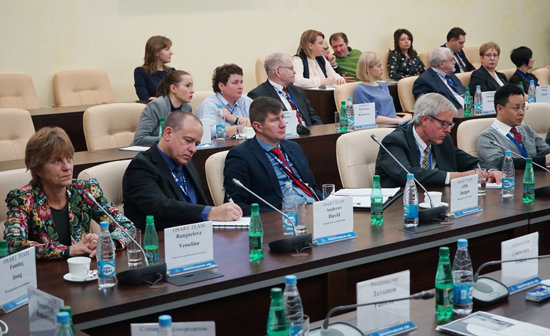01.12.2017
INFORMATION AND PUBLIC RELATIONS DEPARTMENT OF LENINGRAD NPP

OSART mission of the IAEA noted Leningrad NPP’s commitment to safety

Experts from the International Atomic Energy Agency (IAEA) noted the commitment of Leningrad Nuclear Plant to safety and its active continuous improvement in this direction.
On 30 November, 2017, the IAEA Operational Safety Review Team (OSART) summed up the results of a 17-day operational safety assessment mission at the Nuclear Plant’s power unit No 4 with water cooled graphite moderated reactors (RBMK-1000) that was included to power grid in 1981.
OSART missions are aimed at improving the operational safety of nuclear facilities by objectively evaluating their work based on the IAEA safety standards and making recommendations for implementing improvements, if necessary. The share of nuclear energy in Russia’s electric energy generation is over 18%. 35 power units are in operation in the country. Another seven units are under construction, and two of them are pressurized water reactors (VVER-1200) of Leningrad NPP site.
“Leningrad Nuclear Power Plant carried out a thorough self-assessment of compliance with the IAEA standards; it resulted in implementing such improvements as implementation of an integrated management system”, Vesselina Rangelova, a leading nuclear safety expert at the IAEA, said. ‘The implementation of the proposals made by the OSART team will help to further improve the level of the Plant’s operational safety, and the identified good practices, if implemented elsewhere, will contribute to improving the level of safety worldwide.”
The OSART team consisted of 12 experts from Belgium, Brazil, Canada, China, the Czech Republic, France, Romania, Slovakia, South Africa, Sweden, as well as two representatives of the IAEA. The assessment was conducted in the following areas: leadership and management for security purposes; training and qualification; operation; maintenance and repair; technical support; use of operational experience; radiation protection; chemistry and accident management.
The team identified a number of good practices that will be useful to the world nuclear community, for example:
- the use of a full-scale simulator for emergency response drills.
- the development of a corrosion efficient control system inside the cooling circuit of the generator stator.
- the use of complex probabilistic safety analysis during the decision-making and staff training.
The team also identified areas for further improvement, and formulated a number of proposals to improve operational safety, including:
- The Plant should use proactive indicators to further improve its performance;
- The Plant should improve the radiation control program;
- The Plant should regularly review the chemical control program and maintain the water-chemistry conditions to ensure its continuous improvement.
“OSART mission is a unique opportunity for Leningrad NPP to conduct an independent assessment that will help improve operational safety of the Plant”, Vladimir Pereguda, the Plant Manager of Leningrad NPP, said. “Leningrad NPP is the sixth Russian plant that has been tested for the last 12 years; and the results of the mission will be used both at the operating power units and at those under construction in order to stay on the way to perfection.”
The team sent the draft report to the Plant’s management. The Management and the Federal Environmental, Industrial and Nuclear Supervision Service (Rostekhnadzor), which is responsible for nuclear and radiation safety in the country, will have the opportunity to send their comments on the draft report to the IAEA for consideration. The final report will be sent to the Government of the Russian Federation within three months.
General information on OSART missions is available on the IAEA website. OSART mission is organized as an audit of programs and activities important for operational safety. The Mission is not an inspection oversight audit, nor a project check or an in-depth evaluation of the overall safety status of the plant. This is 198th mission under the OSART program, which has existed since 1982.
The Leningrad NPP is an affiliate company for Rosenergoatom Concern OJSC. The plant is based in the city of Sosnovy Bor, 40 km to the west from Saint Petersburg at the Gulf of Finland shore. The Leningrad NPP is the first Russian nuclear power plant having RBMK-1000 reactors (uranium-graphite channel-type thermal neutron reactors). The NPP exploits 4 power blocks with the electric capacity of 1000 megawatt each. Also, pursuant to the NPP-2006 project, 1,2 VVER-1200 power blocks included into The State Atomic Energy Corporation ROSATOM long-term plan are being constructed. Rosenergoatom Concern OJSC is the owner and developer of the project. Holding TITAN-2 is the primary contractor. ATOMPROEKT is the general designer.

 career
career Innovations
Innovations Projects
Projects INTERNATIONAL BUSINESS
INTERNATIONAL BUSINESS